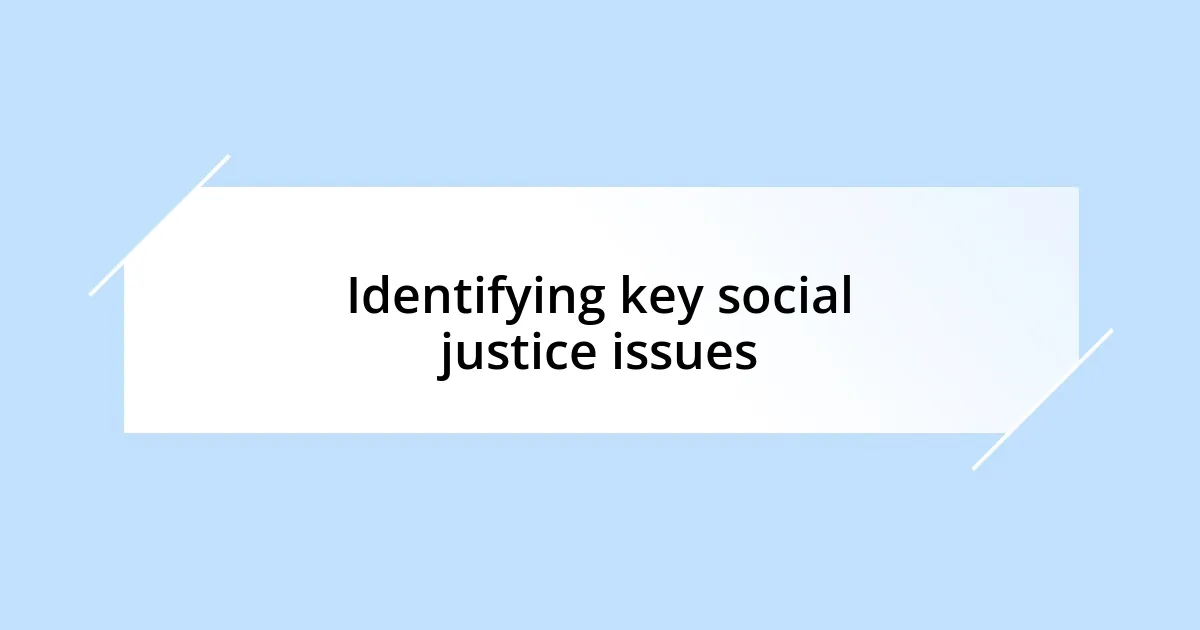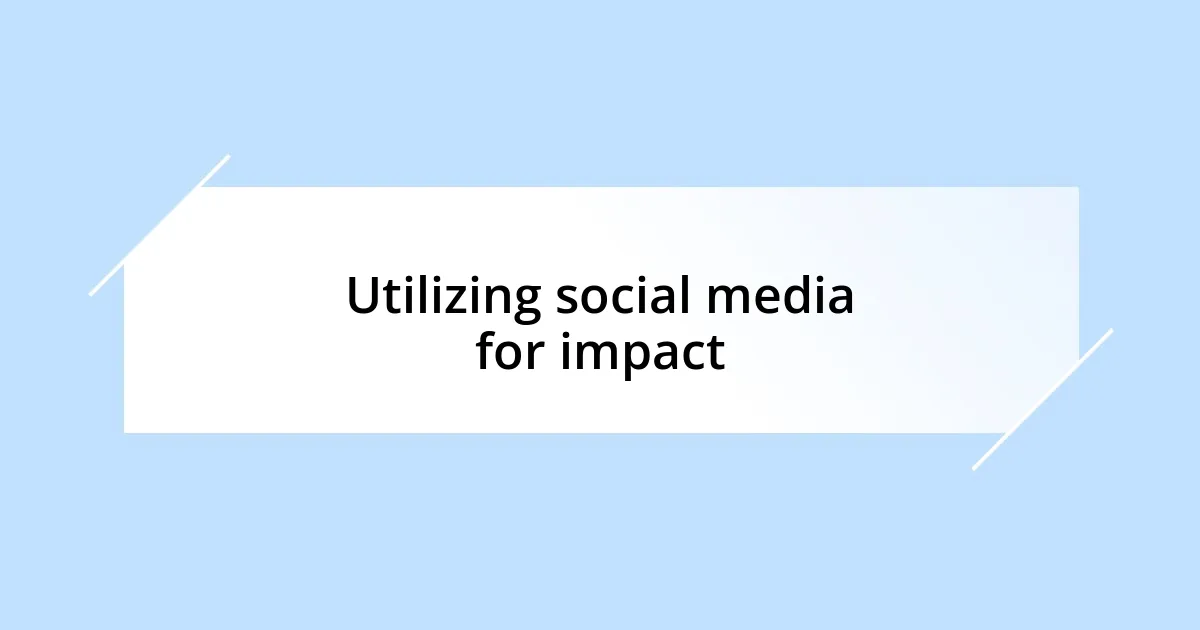Key takeaways:
- Social justice advocacy focuses on amplifying marginalized voices and addressing systemic issues through empathy and collaboration.
- Key social justice issues include racial injustice, economic inequality, gender inequality, climate justice, and LGBTQ+ rights.
- Effective community organizing relies on shared goals, persistent engagement, and recognizing progress to sustain motivation.
- Social media serves as a powerful tool for advocacy by facilitating real-time dialogue and amplifying important social justice messages.

Understanding social justice advocacy
Understanding social justice advocacy involves recognizing the systemic issues that affect marginalized communities. I remember attending a community meeting a few years ago, where members shared their struggles against injustice; it was eye-opening to see how deeply interconnected our stories are. Have you ever felt that stir of responsibility when you hear another person’s plight?
At its core, social justice advocacy means amplifying voices that often go unheard, pushing for equity and fair treatment across all aspects of society. When I first engaged in advocacy, it struck me how a single conversation could change someone’s perspective. It made me realize that empathy and understanding are as powerful as any legislative change. Isn’t it incredible how our actions can inspire others to join the fight?
Moreover, advocacy isn’t just about raising awareness; it’s about creating tangible change in policies and practices. I recall organizing a local campaign that addressed housing discrimination, and witnessing the community come together was both humbling and empowering. This experience revealed to me that advocacy is not a solitary endeavor; instead, it thrives on collaboration and shared goals. How have you contributed to your community’s progress?

Identifying key social justice issues
Identifying key social justice issues requires a keen awareness of the injustices that persist in our society. One day, while volunteering at a local shelter, I was taken aback by how the stories of the residents revealed deep-seated issues such as poverty, homelessness, and systemic racism. Each narrative felt like a thread in a larger tapestry of inequality, urging me to pay attention to the patterns of oppression that often go unnoticed.
When I think about the pressing issues today, several stand out:
- Racial injustice – Numerous communities face discrimination based on race, impacting their access to opportunities.
- Economic inequality – The widening gap between the rich and poor raises significant concerns about equity in resources.
- Gender inequality – Women and non-binary individuals often experience disparities in wages, representation, and safety.
- Climate justice – Environmental issues disproportionately affect marginalized groups and indigenous communities.
- * LGBTQ+ rights* – Ongoing discrimination and violence against LGBTQ+ individuals highlight the need for inclusive policies.
Reflecting on these issues motivates me to advocate for meaningful change. Just last year, I attended a rally focused on climate justice, where I felt a profound connection with fellow advocates. It emphasized that understanding the issues is the first step toward advocating effectively.

Building a strong advocacy network
Building a strong advocacy network is vital for spreading awareness and creating impactful change in social justice efforts. From my experience, connecting with like-minded individuals can be incredibly energizing. I still remember the first gathering I attended where everyone shared their passion for justice; it was as if a spark ignited within me. Have you ever been in a room where the collective energy makes you feel unstoppable?
Forming partnerships with local organizations amplifies our voices and strengthens our campaigns. For instance, when I collaborated with a nearby nonprofit focused on education equity, I witnessed firsthand how pooling resources can lead to more substantial initiatives. The sheer diversity of perspectives and skills brought to the table was invaluable. If you’ve ever teamed up with others, you might recognize how shared passions can create opportunities you hadn’t even considered before.
A successful advocacy network thrives on trust and open communication. I learned this during a series of workshops I organized, where participants openly discussed their vulnerabilities. Creating that safe space for dialogue not only fostered camaraderie but encouraged each of us to explore new ideas. How do you build trust within your community? In my view, it’s through consistent engagement and support—ensuring everyone feels their voice matters.
| Advocacy Network Elements | Description |
|---|---|
| Partnerships | Collaborate with local organizations to pool resources and amplify efforts. |
| Trust Building | Foster open communication to ensure every voice is heard and valued. |
| Diverse Perspectives | Encourage inclusion of varying opinions, enriching discussions and approaches. |
| Shared Goals | Establish common objectives to unify efforts toward tangible change. |

Developing effective communication strategies
Effective communication strategies are crucial in advocating for social justice. I remember a workshop where I first learned about the power of active listening. It wasn’t just about waiting for my turn to speak; it was about truly understanding the feelings and concerns of others. Have you ever felt heard in a conversation? That feeling of validation can motivate individuals to engage more deeply in social justice dialogues.
Utilizing storytelling also has a profound impact on communication. One time, I shared my own experience with bias during a community meeting, and the room fell silent. I realized that my vulnerability opened the door for others to share their experiences too. This exchange created an atmosphere of empathy and understanding. When we convey our messages through personal narratives, we create connections that resonate on an emotional level.
Additionally, adapting your message to your audience is key. For instance, when addressing school students, I’ve found that using relatable language and real-life examples makes complex issues more accessible. Have you noticed how sometimes, a simple analogy can spark an “aha” moment? Tailoring your approach ensures that your communication is meaningful, fostering a sense of shared purpose among advocates.

Engaging in community organizing
Engaging in community organizing requires a blend of passion and strategy. I vividly recall my first experience with grassroots organizing when we launched a neighborhood cleanup initiative. The excitement in the air was palpable as residents came together, not just to pick up trash, but to envision a cleaner, safer space for our kids to play. Have you ever felt the satisfaction of working side by side with others for a common purpose? There’s something truly special about it.
In my journey, I’ve found that effective community organizing hinges on identifying shared goals. During a recent campaign for local housing rights, we organized a series of forums to bring diverse voices into the conversation. I was amazed at how residents, often silenced by their circumstances, began to share their stories. It turned out our goals aligned more than we ever expected, creating an avenue for collective action. Have you experienced that moment when unexpected alliances form? These connections forge stronger communities and pave pathways for real change.
Lastly, persistence in community organizing has taught me the importance of follow-up. After the initial excitement of an event, we made it a point to keep the momentum alive. I remember sending out newsletters highlighting our achievements, which kept everyone engaged and motivated. It’s vital to acknowledge progress, no matter how small, to maintain spirits. What strategies do you use to ensure ongoing engagement? From my perspective, continuous communication and recognition can make all the difference in sustaining the passion and commitment of everyone involved.

Utilizing social media for impact
Utilizing social media for impact can be a game-changer for social justice advocacy. I vividly remember the first time I created a hashtag to highlight an issue within my community. It felt exhilarating to see it trend locally, allowing voices that often go unheard to finally be amplified. Have you ever felt that thrill when your message strikes a chord with others? It’s a powerful reminder of how quickly social media can mobilize support and create conversations.
Social media also allows us to share information in real time, which can be crucial during a crisis. I once live-tweeted a community forum addressing police brutality, and the engagement was incredible. People from various backgrounds joined the discussion, contributing insights that I hadn’t even considered. It was an eye-opening moment for me—something clicked, and I realized that these digital platforms are not just about broadcasting messages but building dialogue. Isn’t it fascinating how a simple tweet can turn into a catalyst for meaningful change?
Moreover, I’ve learned that visuals have an undeniable impact in this space. I experimented with creating infographics that simplified complex statistics about social inequality. The responses were overwhelming; sharing this data visually not only made it more accessible but encouraged people to share it within their circles. Have you noticed how compelling images can change perspectives? For me, every share represented a ripple effect, extending our reach beyond what we could ever achieve alone.

Measuring advocacy success and outcomes
Measuring advocacy success involves looking at both qualitative and quantitative outcomes. I remember when we evaluated a campaign aimed at improving public transportation accessibility. Instead of just counting attendees at our meetings, we gathered stories from individuals who shared how changes impacted their daily lives. Have you ever thought about the deeper impact your work has? Those personal testimonies provided a rich tapestry of success that numbers alone could never capture.
Data can tell part of the story, but it’s also essential to track ongoing engagement. During a recent initiative, we used surveys to assess community awareness before and after our outreach events. Initially, I was surprised to find that only 30% of respondents knew about our mission; however, after our efforts, that number skyrocketed to 85%. Isn’t it remarkable to see such growth? This shift showed us that our strategies were not only effective but also highlighted the need for continuous evaluation as we move forward.
Ultimately, the most rewarding aspect of measuring success is seeing the direct change we inspire. I recall a poignant moment at a city council meeting when a former participant of our advocacy group shared how their life had transformed since gaining access to supportive resources. Hearing their story brought tears to my eyes and reaffirmed the importance of my work. Have you felt that rush of purpose when your efforts resonate with someone’s life? Such moments are the best indicators of advocacy success, reminding me that the heart of our work is about real people and their journeys.














